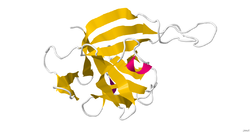Source
Poison ivy, also known as Toxicodendron radicans, is a poisonous plant that characteristically has three leaves – as the saying goes “leaves of three, let it be.”
The vast majority of people (>85%) are allergic to poison ivy. Poison ivy grows everywhere in the United States except Hawaii, Alaska and some deserts in Nevada. (American Skin Association, American Osteopathic College of Dermatology).
The above chart is helpful in identifying poison ivy.
This map shows where Eastern Poison Ivy is found.
This map shows where Western Poison Ivy is found.
Biotransformation
N/A
Toxicokinetics
The causative agent in poison ivy, urushiol, is absorbed through the skin. From there, an allergic reaction ensues, and the immune system becomes activated. The rash is usually self-limiting, and the rash will eventually clear up, often without treatment.
Urushiol

Carcinogenicity
Poison ivy is not known to be carcinogenic.
Mechanism of Action
The causative agent of poison ivy dermatitis is a substance found on the surface of the leaves called urushiol. After coming into contact with this substance, an allergic skin reaction typically ensues. (American Skin Association, American Osteopathic College of Dermatology).
The immune system produces a protein called interleukin 33 (IL-33), which is what triggers the itching associated with poison ivy dermatitis. In addition to causing inflammation, this protein is also capable of acting on nerves. (Researchers Identify Protein That Triggers Poison Ivy Itch).
Interleukin-33

Target organ(s)
- Skin
- Poison ivy can also be inhaled in some cases if it is burned and enters the air, affecting the respiratory system.
Signs and symptoms of toxicity
- Redness
- Itchiness
- Swelling
- Blisters
- If inhaled, can cause difficulty breathing
- Anaphylaxis in extreme situations
This image shows an example of poison ivy dermatitis.
Genetic susceptibility or heritable traits
The vast majority of people are allergic to poison ivy (>85%), and it is unknown whether or not people are more susceptible as a result of genetics. (American Skin Association, American Osteopathic College of Dermatology).
Historical or unique exposures
- Historically, it was thought that poison ivy could be used for medical purposes and healing.
- André-Ignace-Joseph Dufresnoy, a physician in the 1700’s, was very interested in the effects of poison ivy and attempted to create medicines from poison ivy to heal skin wounds and even cure paralysis. He made a distilled extract using poison ivy and prescribed it to patients to attempt to “heal them.” He claimed to have positive results, but poison ivy is not used for these purposes today.
- A Japanese chemist named Rikou Majima (pictured below) was the first to identify the causative agent in poison ivy as urushiol.
Here is a picture of Rikou Majima with his students.
(No Ill Nature: The Surprising History and Science of Poison Ivy and Its Relatives).
Treatments
In most cases, the rash is self-limiting and will heal on its own within two to three weeks. Thus, treatment is not usually required. However, some treatments exist:
- over the counter corticosteroid cream
- calamine lotion
- oatmeal baths
- oral antihistamines (diphenhydramine)
- soak in a cold water bath
- apply a cool compress to the affected area
- in some cases, your doctor may prescribe a steroid such as prednisone
Oatmeal baths can be helpful to get rid of itchiness.
Biomarkers
N/A
Disclaimer: I do not own any of these images or videos. They have been cited with their appropriate link.
References
1. Poison ivy dermatitis—American Osteopathic College of Dermatology (AOCD). https://www.aocd.org/page/PoisonIvyDermatiti. Accessed July 21, 2019.
2. Poison ivy, sumac and oak | American Skin Association. http://www.americanskin.org/resource/poisonivy.php. Accessed July 21, 2019.
3. Poison ivy rash—Symptoms and causes. Mayo Clinic. https://www.mayoclinic.org/diseases-conditions/poison-ivy/symptoms-causes/syc-20376485. Accessed July 21, 2019.
4. Poison ivy rash—Diagnosis and treatment—Mayo Clinic. https://www.mayoclinic.org/diseases-conditions/poison-ivy/diagnosis-treatment/drc-20376490. Accessed July 21, 2019.
5. No ill nature: The surprising history and science of poison ivy and its relatives. Science History Institute. https://www.sciencehistory.org/distillations/no-ill-nature-the-surprising-history-and-science-of-poison-ivy-and-its-relatives. Published June 2, 2013. Accessed July 21, 2019.
6. Researchers identify protein that triggers poison ivy itch. National Institute of Environmental Health Sciences. https://www.niehs.nih.gov/research/supported/sep/2017/protein-poison-ivy-itch/index.cfm. Accessed July 21, 2019.
7. U.S. Food and Drug Administration. 4 Tips to Outsmarting Poisonous Plants. https://www.youtube.com/watch?v=CEBpYdgBALg&feature=youtu.be. Accessed July 21, 2019.
8. Centers for Disease Control and Prevention (CDC). How Poison Ivy Works. https://www.youtube.com/watch?v=dgwQ1DHepOw&feature=youtu.be. Accessed July 21, 2019.
9. Mayo Clinic. Mayo Clinic Minute: How to Treat Poison Ivy Rash. https://www.youtube.com/watch?v=G5mBkVdsoEE&feature=youtu.be. Accessed July 21, 2019.






